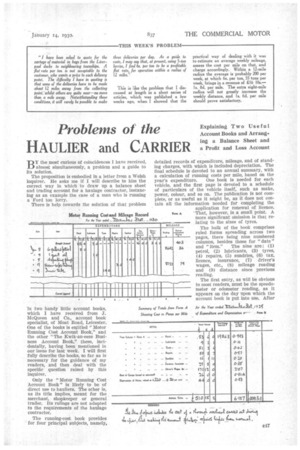Problems of the
Page 69

Page 70

If you've noticed an error in this article please click here to report it so we can fix it.
HAULIER and CARRIER Explaining Two Useful Account Books and Arranging a Balance Sheet and a Profit and Loss Account BY the most curious of coincidences I have received, almost simultaneously, a problem and a guide to its solution.
The proposition is embodied in a letter from a Welsh inquirer. He asks me if I will describe to him the correct way in which to draw up a balance sheet and trading account for a haulage contractor, instancing as an example the case of a man who is running a Ford ton lorry.
There is help towards the solution of that problem
In two handy little account books, which I have received from J. McQueen and Co., account book specialist, of Moat Road, Leicester. One of the books is entitled "Motor
• Running Cost Account Book," and the other "The Kwik-an-eeze Business Account Book," these, incidentally, having been mentioned in our issue for last week. I will first fully describe the books, so far as is necessary for the guidance of my readers, and then deal with the specific question raised by this inquirer.
Only the "Motor Running Cost Account Book" is likely to be of direct use to hauliers. The other is, as its title implies, meant for the merchant, shopkeeper or general trader. Its rulings are not adapted to the requirements of the haulage contractor.
The running-cost book provides ' for four principal subjects, namely,
detailed records of expenditure, mileage, and of standing charges, with which is included depreciation. The final schedule is devoted to an annual summary, with a calculation of running costs per mile, based on the year's expenditure. One book is needed for each vehicle, and the first page is devoted to a schedule of particulars of the vehicle itself, such as make, power, colour, and so on. The publication is not complete, or as useful as it might be, as it does not contain all the information needed for completing the application for renewal of licence. 'That, however, is a small point. A more significant omission is that relating to the sizes of tyres.
The bulk of the book comprises ruled forms spreading across two pages, there being nine numbered columns, besides those for " date "
and "item." The nine are: (1) petrol, (2) lubricants, (3) tyres, (4) repairs, (5) sundries, (6) tax, licence, insurance, (7) driver's wages, etc., (8) mileage reading and (9) distance since previous reading.
The first entry, as will be obvious to most readers, must be the speedometer or odometer reading, as it appears on the day upon which the account book is put into use. After for the Year ended 110.416,1&3i,d,1 9 24 of Expenditure and Deprecation Form El
that readings will be taken daily and columns 8 and 9 completed accordingly.
For the rest, the book is a convenient means for entering expenditure as it occurs, each item necessitating one line. Readers who are accustomed to The Commercial Motor method of scheduling operating costs should note that the two columns, (4) and (5), for repairs and sundries, together make up the one item "maintenance." There is no provision in the form for any reference to depreciation, or for rent and rates of the garage in which the vehicle is housed.
At the end of the year, the total of expenditure on each item is entered on a second form, B. (Both forms A and B are reproduced herewith.) On this sheet provision is made for entering expenditure on rent and rates, also for an amount for depreciation, which is, according to this method, calculated annually on some stipulated percentage of the book value of the machine at the commencement of the financial year, whenever that may be.
There does not appear to be any particular need for the last column, but I have, in the illustration, completed it, in accordance with the imaginary figures of cost which are shown in the forms. I should add, too, that notwithstanding the foregoing criticisms, I consider this a most useful publication, and as good as any on the market.
The other account book does not call for detailed review, as it is not adapted to the business of a haulage contractor. No doubt the publisher would, on request, be glad to suggest and submit rulings suitable for that business. At the moment our concern with this second publication is that it gives us the basis for a simple balance sheet and trading account, such as my Welsh correspondent would find useful for his business.
I have taken the profit and loss account and the balance sheet from the Kwick-and-eeze book of Jas. McQueen andCo., and have modified them to meet the requirements of a haulage contractor. The forms
are, I think, self-explanatory. S.T.R.












































































































